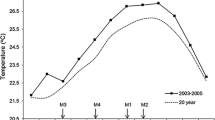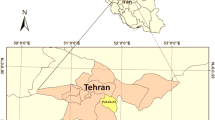Abstract
Development of maize (Zea mays L.) types that produce leaf area and mature quickly would increase production of maize in mid- to short-season areas. The leafy (Lfy1) and reduced-stature (rd1) traits both make contributions to this end. However, these two traits have not previously been combined. Our objective was to evaluate the yield and yield components of non-leafy normal-stature (NLNS), leafy reduced-stature (LRS), non-leafy reduced-stature (NLRS), and leafy normal-stature (LNS) maize inbred lines. The two genes, ‘Lfy1’ and ‘rd1’, were incorporated into a series of inbred lines resulting in a range of canopy architectures. Ten variables were recorded for each of 30 inbred lines over three years. The 10 variables were: corn heat unit requirement from planting to tasselling, corn heat unit requirement from planting to silking, days between tasselling and silking, grain moisture content, husk dry weight, cob dry weight, ear length, maximum ear circumference, grain yield and ratio of grain yield to moisture content. Reduced-stature inbred lines reached anthesis more quickly than normal-stature inbred lines. Grain moisture content was less in reduced-stature inbred lines than normal stature trait groups. Leafy-reduced stature plants had the highest ratio of grain to moisture content and the lowest grain moisture content at harvest. Inbred lines containing the rd1 trait matured more rapidly than other trait groups. The LRS trait group yielded more than the other groups, and showed great potential for use in mid- to short-season environments.
Similar content being viewed by others
References
Afuakwa, J.J. & R.K. Crookston, 1984. Using the kernel milk line to visually monitor grain maturity in maize. Crop Sci 24: 687–691.
Aldrich, S.R., W.O. Scott & R.G. Hoeft, 1986. Modern corn production. A. and Publ., Champaign, IL.
Bassetti, P. & M.E. Westgate, 1994. Floral asynchrony and kernel set in maize quantified by image analysis. Agron J 86: 699–703.
Brown, D.M. & A. Bootsma, 1993. Crop heat units and other warm season crops in Ontario. Ont Minist Agric Food Factsheet, Agdex 111/31, ISSn No. 0225-7882. Ontario Ministry of Agriculture and Food, Queen's Park, Toronto, Ontario, Canada. 4 pp.
Burris, J.S. & K.H. Knittle, 1985. Freeze damage and seed quality in hybrid maize. pp. 51–74. In: J.S. Burris (Ed.) Proc 7th Ann Seed Tech Conf, Ames, IA. 26–27 February. Seed Science Centre, Iowa State University, Ames.
Carter, M.W. & C.G. Poneleit, 1973. Black layer maturity and filling period variation among inbred lines of corn (Zea mays L.). Crop Sci 13: 436–439.
Chase, S.S. & D.K. Nanda, 1967. Number of leaves and maturity classification in Zea mays L. Crop Sci 7: 431–432.
Corke, H. & L.W. Kannenberg, 1989. Selection for vegetative phase and actual filling period duration in short-season maize. Crop Sci 29: 607–612.
Cross, H.Z. & M.S. Zuber, 1973. Interrelationships among plant height, number of leaves, and flowering dates in maize. Agron J 65: 71–74.
Cross, H.Z., 1985. A selection procedure for ear-drying rates in maize. Euphytica 34: 409–418.
Cross, H.Z., J.R. Chyle, Jr. & J.J. Hammond, 1987. Divergent selection for ear moisture in early maize. Crop Sci 27: 914–918.
Daynard, T.B. & W.G. Duncan, 1969. The black layer and grain maturity in corn. Crop Sci 9: 473–476.
Daynard, T.B. & L.W. Kannenberg, 1976. Relationships between length of the actual and effective grain filling periods and the grain yield of corn. Can J Plant Sci 56: 237–242.
Daynard, T.B., J.W. Tanner & W.G. Duncan, 1971. Duration of the grain filling period and its relation to grain yield in corn. Crop Sci 11: 45–48.
Derieux, M., 1978. Etude de quelques facteurs d'adaptation du mais aux conditions climatiques du nord de la France. Ann Amélior Plantes 28: 529–566.
Frey, N.M., 1981. Dry matter accumulation in kernels of maize. Crop Sci 21: 118–122.
Hicks, D.R., J.L. Geadelmann & R.H. Peterson, 1976. Drying rates of frosted maturing maize. Agron J 68: 452–455.
Hunter, R.B., 1980. Increased leaf area (source) and yield of maize in short-season areas. Crop Sci 20: 571–574.
Hunter, R.B., L.A. Hunt & L.W. Kannenberg, 1974. Photoperiod and temperature effects in corn. Can J Plant Sci 54: 71–78.
Knittle, K.H. & J.S. Burris, 1976. Effect of kernel maturation on subsequent seedling vigour in maize. Crop Sci 16: 851–855.
Muldoon, J.F., T.B. Daynard, B. Van Duinen & M. Tollenaar, 1984. Comparisons among rates of appearance of leaf tips, collars, and leaf area in maize (Zea mays L.). Maydica 29: 109–120.
Neal, N.P., 1961. The influence of freezing temperature of varying intensities and duration on the germination of seed corn at different stages of maturity. pp. 67–73. In: 16th Annu Hybrid Corn Ind Res Conf, ASTA, Washington, DC.
Olson, R.A. & D.H. Sander, 1988. Corn production. In: G.F. Sprague & J.W. Dudley (Eds.) Corn and Corn Improvement. 3rd edition, # 18 Agron Series, Americ Soc Agron, Madison.
Shaver, D.L., 1983. Genetics and breeding of maize with extra leaves above the ear. Proc Annu Corn Sorghum Res Conf 38: 161–180.
Steel, R.G.D. & J.H. Torrie, 1980. Principals and procedure of statistics. McGraw-Hill, New York.
Tollenaar, M. & T.B. Daynard, 1978. Effect of defoliation on kernel development in maize. Can J Plant Sci 58: 207–212.
Troyer, A.F. & W.B. Ambrose, 1971. Plant characteristics affecting field drying rate of ear corn. Crop Sci 11: 529–531.
Author information
Authors and Affiliations
Rights and permissions
About this article
Cite this article
Modarres, A., Hamilton, R., Dwyer, L. et al. Leafy reduced-stature maize for short-season environments: Yield and yield components of inbred lines. Euphytica 97, 129–138 (1997). https://doi.org/10.1023/A:1002953906498
Issue Date:
DOI: https://doi.org/10.1023/A:1002953906498




